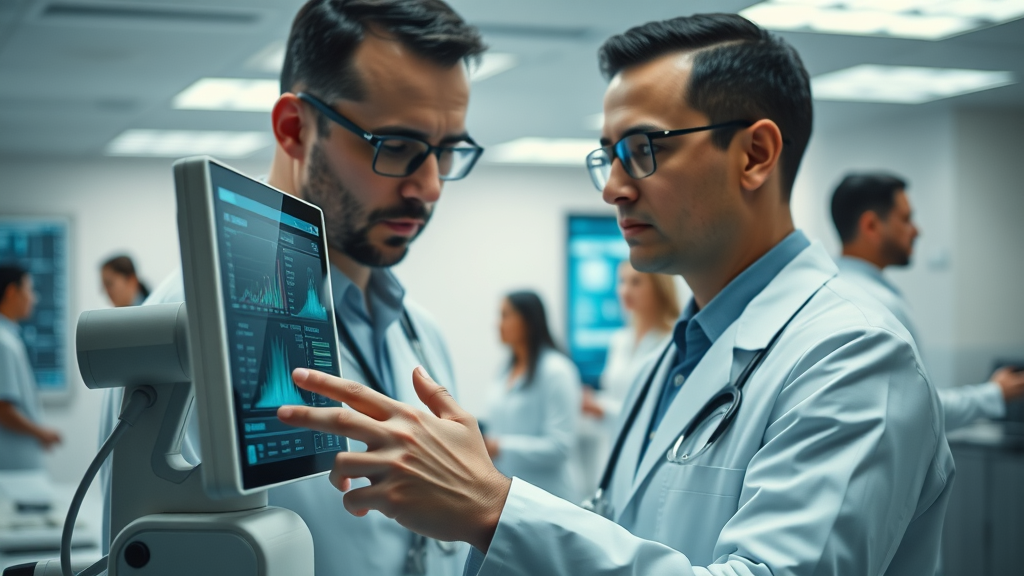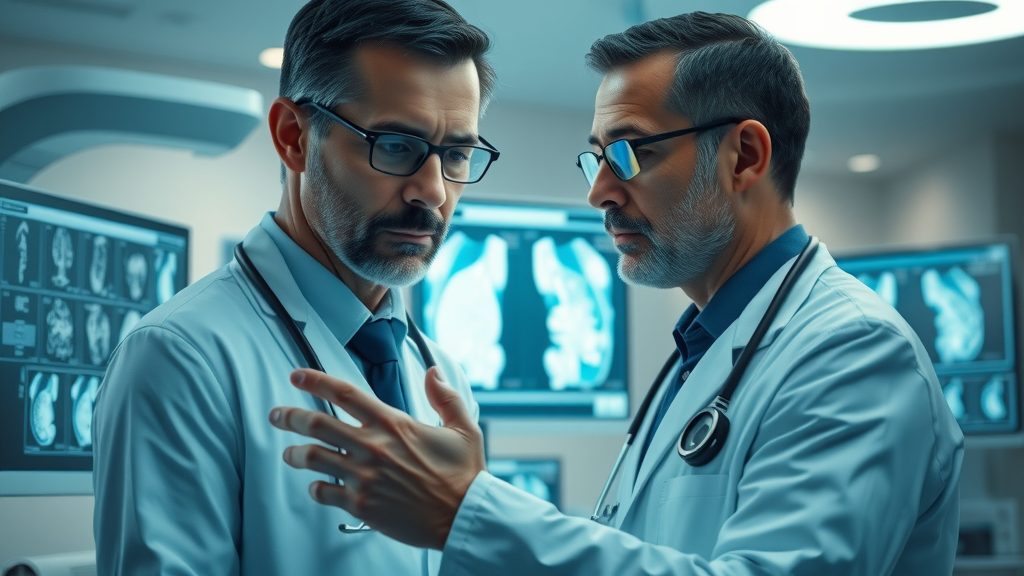Every year, diagnostic errors account for nearly 10% of patient deaths. Can AI diagnostics rewrite the future of healthcare by eliminating these deadly mistakes?
- The root causes of misdiagnoses
- How artificial intelligence revolutionizes clinical practice
- Concrete examples of AI diagnostics improving health outcomes
- Expert perspectives on the impact of AI tools in healthcare systems
Imagine visiting your doctor for a routine check-up, only to become a part of a staggering statistic: nearly 10% of patient deaths each year trace back to diagnostic errors . These mistakes don’t just cost lives—they shake the very foundation of trust in our healthcare systems . Now, with the rapid rise of AI diagnostics , we stand at a crossroads. Can these advanced tools truly prevent misdiagnoses and usher in a new era of reliable, data-driven health outcomes ? Let’s dive into how artificial intelligence is poised to transform clinical practice —not by replacing care professionals, but by empowering them to save more lives.
The Promise of AI Diagnostics in Shaping Health Outcomes
The idea of leveraging artificial intelligence to improve health outcomes isn’t science fiction—it’s happening today across major healthcare systems . From machine learning models that analyze medical images at lightning-fast speeds to AI algorithms that predict patterns no human could discern, the goal is clear: improve patient outcomes by eliminating the guesswork in the diagnostic process .
Perhaps the most significant promise of AI diagnostics is its potential to systematically reduce diagnostic errors. By offering unbiased, data-driven decision support and flagging subtle findings in medical imaging , AI assists care providers in spotting complex or rare conditions early. Deep learning models, for instance, can learn from a vast pool of patient data , continuously improving their accuracy as more information is fed into them. As more medical professionals integrate AI into their routine, the industry expects to see radical improvements in patient care and outcomes.
Unpacking the Misdiagnosis Epidemic in Healthcare Systems
- Key statistics on health outcomes related to diagnostic errors
- Role of clinical practice gaps
The scale of misdiagnoses has long haunted healthcare systems globally. Studies reveal that nearly one in twenty adult patients are misdiagnosed during their lifetime, with a significant fraction experiencing severe harm. These diagnostic errors are not just numbers: they represent missed opportunities for early intervention and lives lost unnecessarily. The root causes often stem from gaps in clinical practice —rushed appointments, cognitive biases, and the overwhelming complexity of variables in patient data .
These setbacks are compounded by uneven access to advanced testing and the varying expertise among healthcare professionals . The modern diagnostic process , though improved by technology, still fails in critical moments because of fragmented information and overburdened care systems . More than ever, integrating AI tools into daily workflows is no longer optional—it is essential for closing these dangerous gaps and maximizing health outcomes .
"Artificial intelligence in diagnostics could reduce diagnostic errors by up to 40%, according to recent studies."
How AI Diagnostics Use Deep Learning to Revolutionize Clinical Practice
AI diagnostics owe much of their success to deep learning —a class of machine learning that mimics the human brain’s neural networks. These systems are particularly adept at sifting through massive datasets, such as medical images , health records, and genomics, to identify subtle patterns often invisible to even the most skilled care providers . This predictive power enables AI tools not only to flag evident issues but also to reveal previously undetectable risks and correlations, leading to earlier and more accurate interventions.
The practical implications extend far beyond theoretical benefits. In day-to-day clinical practice , AI applications can analyze a CT scan in seconds, provide recommendations for rare disease testing, or spot emergent trends across thousands of patients . By embedding AI systems into existing decision support frameworks, healthcare organizations can deliver safer, more consistent care—and dramatically improve patient outcomes .
The Role of Machine Learning in Accurate Disease Detection
- Case studies on ai diagnosis of cancer, heart disease, and rare illnesses
- Deep learning's predictive capabilities in health outcomes
Machine learning , at the heart of ai diagnosis , has produced transformational case studies across healthcare. For instance, deep learning networks trained on mammograms can catch early-stage breast cancer with accuracy rivaling or surpassing radiologists, even in dense tissue cases where human judgment often falters. Similarly, specialized ai algorithms have recently shown promise in detecting subtle EKG changes indicating heart disease long before symptoms emerge.
In the realm of rare illnesses, where misdiagnosis rates soar, ai applications offer new hope. By matching an individual’s symptoms and test results to a global dataset, AI tools identify disease signatures that would otherwise go unnoticed in standard clinical practice . Predictive learning models are now pushing the boundaries in rare genetic disorder identification and optimizing clinical trial recruitment based on precise phenotype matching—demonstrating that the integration of deep learning improves real-world health outcomes .

AI Tools Driving Change in Healthcare Systems Worldwide
The adoption of AI tools across healthcare systems is accelerating, as leaders recognize their transformative impact on patient care . Today, hospitals on every continent incorporate AI-powered platforms for the diagnostic process , from early cancer detection to triaging stroke victims. These AI systems supplement the intuition of medical professionals with data-driven precision, narrowing the window for human error and ensuring more reliable clinical decision making.
Yet, even the most advanced ai app comes with nuances. Healthcare professionals must weigh the tremendous benefits—faster turnaround times, scalable expertise, and enhanced accuracy—against operational constraints, such as training requirements and system interoperability. Moreover, as more healthcare systems procure these tools, it becomes crucial to address questions around access, affordability, and the ethical use of patient data .
Integrating AI Diagnostics into Everyday Clinical Decision-Making
- Review of top ai tools adopted by leading healthcare systems
- Benefits and limitations of ai in health settings
The integration of AI diagnostics into daily routines has shifted the landscape for clinical decision support . Hospitals now employ AI-powered imaging analysis, electronic symptom checkers, risk prediction algorithms, and triage bots. These innovations act as a second set of expert eyes—reviewing scans, suggesting next steps, or even warning clinicians of a potentially missed diagnosis. Deep learning in medical imaging , for example, has dramatically reduced reading times for critical findings such as pulmonary embolisms or intracranial hemorrhages.
However, AI in health settings is not without limitations. While ai diagnosis increases speed and accuracy, over-reliance can introduce new risks—such as "automation bias," where clinicians may accept AI-suggested results without critical evaluation. There remains the necessity for robust oversight and ongoing education among care professionals . Still, when thoughtfully integrated, AI tools consistently demonstrate an ability to elevate standards and safety of patient outcomes .
| AI Tool Name | Performance Metric | Disease Target | Adoption Rate (%) |
|---|---|---|---|
| Google DeepMind Health | 94% diagnostic accuracy for diabetic retinopathy | Ophthalmology | 60% |
| IBM Watson Health | 75% accuracy in oncology reports | Cancer | 45% |
| Arterys | 98% sensitivity for cardiac MRI analysis | Cardiology | 30% |
| PathAI | 89% accuracy in pathology slides | Cancer, Infectious Disease | 20% |

Opinion: Can AI Diagnostics Truly End Misdiagnosis?
Despite undeniable progress, it’s critical to question if AI diagnostics can fully eliminate the specter of misdiagnosis in our healthcare systems . While artificial intelligence offers unprecedented capabilities—spotting hidden dangers, scaling expert insights to every clinic, and enabling continuous monitoring—it isn’t infallible. AI tools still reflect the biases and blind spots present in their training data, and there are times when human intuition and empathy outshine algorithmic recommendations.
True progress lies in synergy. The best results emerge when care providers work in partnership with AI, treating it as an intelligent assistant, not a replacement. Organizations must create safeguards, addressing data privacy, algorithm transparency, and the subtle risk of clinicians becoming too reliant on “black box” suggestions. AI in health will reinvent the diagnostic process , but only alongside empowered and well-trained medical professionals .
Lessons from Health Outcomes: What AI Still Gets Wrong
- Ethics, data bias, and the risk of over-reliance in clinical practice—balancing human expertise with ai diagnosis
Integration of AI applications in medicine spotlights enduring ethical dilemmas. When deep learning models are built on biased datasets, they can propagate systemic inequities, potentially misdiagnosing patients from underrepresented groups. Transparency is another hurdle: the “black box” nature of many AI systems means decisions can be hard to explain or audit, which challenges accountability in clinical practice .
Nevertheless, the benefits are clear. AI diagnostics excel in high-pressure situations and can outperform conventional methods in four key ways:
- Speed of analysis
- Reduction in human error
- Ability to identify complex disease patterns
- Support for remote and underserved areas
"AI diagnostics won’t replace clinicians, but those who use AI will replace those who don’t." — Healthcare Futurist
Emerging Trends: The Future of AI in Health and Diagnosis
As artificial intelligence and deep learning mature, their influence on clinical practice will only deepen. Today, research is pushing beyond raw diagnostic power towards “explainable AI,” where algorithms show their work and clinicians can understand the rationale behind a prediction. Federated learning, another trend, enables AI systems to improve by learning from multiple hospitals’ data—without ever moving patient data offsite, thereby protecting privacy.
Patient-centered diagnostic models are also emerging, ensuring recommendations are tailored to unique histories and genetics, not just population averages. Continuous feedback loops, where clinicians validate or correct AI suggestions, will train smarter, safer AI app platforms. Over time, these enhancements will address current limitations while further boosting patient outcomes .

Regulation and Policy Hurdles for AI Diagnostics
The road ahead is paved with regulatory challenges. Global health authorities are struggling to keep pace with the quick uptake of AI-driven diagnostic process tools. Essential issues include ensuring safety and efficacy through clinical validation, mandating transparency in ai algorithms , and addressing liability for errors in AI diagnosis . Balancing innovation with patient protection will be a top priority for policy makers as AI becomes more embedded in healthcare systems .
Furthermore, care systems must establish trust-based frameworks that clarify the role of artificial intelligence in decision making. Regulatory bodies are also considering certification programs for AI tools and ongoing surveillance for unintended harms, all while providing flexibility for future upgrades as deep learning technology evolves.
Real-World Case Studies: Health Outcomes Improved by AI Diagnostics
- Stories from healthcare systems: ai diagnosis of diabetes complications, early cancer intervention, reducing ER readmissions
The true impact of AI diagnostics becomes evident when examining real-world transformations in healthcare systems . For example, in India, deploying AI tools for retinal imaging has significantly improved early detection of diabetic retinopathy, enabling interventions before irreversible blindness occurs. Similarly, U.S. hospitals have implemented ai apps that flag chest X-rays for possible pneumonia, allowing faster triage in ER settings and reducing patient wait times.
Another powerful case can be seen in oncology, where AI algorithms drive early cancer identification. Hospitals partnering with AI applications for histology slides have measurably improved survival rates by catching tumors before they spread. In remote and underserved locations, AI diagnostics provide decision support where specialists are absent, cutting down ER readmissions and saving lives when every minute counts.

People Also Ask: The Facts About AI Diagnostics
How is AI used in diagnostics?
AI diagnostics use machine learning and deep learning technologies to analyze medical images , laboratory results, electronic health records, and patient data . These AI applications identify patterns, flag abnormalities, and recommend next steps. They serve as clinical decision support tools, aiding healthcare professionals in diagnosing diseases quickly and accurately.
How accurate is AI in diagnosis?
The accuracy of AI diagnosis varies by application and data quality, but many AI tools now match or even exceed the diagnostic accuracy of experienced medical professionals in areas like radiology, pathology, and ophthalmology. Ongoing clinical trial data and peer-reviewed studies support claims of up to 94% accuracy in detecting conditions such as diabetic retinopathy and certain cancers, enhancing overall patient outcomes .
Is there an AI tool for medical diagnosis?
Yes, there are numerous AI tools used for medical diagnosis . Examples include IBM Watson Health for oncology, Google DeepMind Health for eye disease, and PathAI for pathology slide review. These AI systems assist clinicians by processing information rapidly and offering data-driven insights to improve health outcomes .
What diseases can be diagnosed with AI?
AI diagnostics can aid in identifying a wide range of diseases, including cancers (breast, lung, and skin), heart disease, diabetic complications, pneumonia, sepsis, rare genetic disorders, and infectious diseases. The versatility of ai diagnosis continues to expand as machine learning models are trained on larger and more diverse datasets.
Addressing Skepticism: Limitations and Risks of AI Diagnostics
While the promise of AI diagnostics is compelling, skepticism remains, especially regarding data security, bias, and transparency. Entrusting critical clinical decision making to an AI app brings risks: protected patient data might be exposed, learning algorithms could reinforce existing disparities, and “black box” predictions limit clinicians’ ability to justify medical choices.
To maintain and build trust, healthcare systems must institute clear guidelines for ai applications : rigorous validation, routine audits against bias, and continuous human oversight. Only by confronting these limitations can care professionals and patients benefit from the transformative power of AI diagnosis .
Ethical Implications and Data Security in Healthcare Systems
- Risks: patient data privacy, algorithmic bias, and decision transparency in artificial intelligence applications
Ensuring ethical AI deployment requires meticulous attention to data privacy. Patient data should be encrypted, anonymized, and processed in compliance with local and international standards. AI algorithms must undergo regular monitoring for bias and fairness, and all clinical decisions influenced by ai systems should be explainable to both clinicians and patients. Transparency is essential for trust and accountability across healthcare systems .
Ongoing education for healthcare professionals is crucial, ensuring clear understanding of both the capabilities and shortcomings of AI tools . This empowers them to make informed, ethical decisions, advancing patient outcomes without sacrificing privacy or autonomy.
"The power of AI diagnostics lies not in replacing clinicians but in augmenting their decision-making capacity."
- FAQs:
- Can AI diagnostics be wrong?
- Who is responsible for an incorrect AI diagnosis?
- Do AI-based diagnoses require physician oversight?
Key Steps to Make AI Diagnostics a Mainstay in Healthcare Systems
Ensuring Equitable Access and Continuous Improvement
- Steps: policy development, ethical framework creation, robust education for clinicians on AI tools, and prioritizing health outcomes
To make AI diagnostics a trusted fixture in the healthcare system , collaboration is essential. First, robust policy development must ensure safety, efficacy, and equitable access to AI tools . Second, ethical frameworks should guide the collection and use of patient data , preventing algorithmic bias and protecting privacy.
Third is comprehensive education for clinicians—training care professionals on both the power and limits of AI systems . Finally, continuous improvement relies on feedback loops: regularly evaluating outcomes, soliciting patient and provider perspectives, and updating learning algorithms as new evidence emerges. With these steps, AI will not just enhance, but help redefine, what it means to deliver excellent patient care .

Moving Forward: Why AI Diagnostics Deserve the Spotlight in Clinical Practice
"The future of reliable healthcare lies at the intersection of human empathy and artificial intelligence."
- AI diagnostics are reshaping healthcare systems and clinical practice
- Risk mitigation and ethical use are crucial
- Ongoing dialogue between patients, clinicians, and AI developers will determine sustainable progress
To ensure a safer future for all, healthcare systems must embrace AI diagnostics ethically, educate their teams, and keep patients at the heart of every step—because in the battle against misdiagnosis, informed collaboration truly saves lives.
 Add Row
Add Row  Add
Add 




Write A Comment